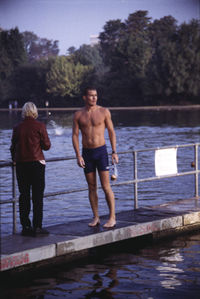Cross Training Guidelines
By Charles Doxat
Charles Doxat was county swimming champion in the early 1960s, and went to be many times British Age Group swimming Champion and record-holder. He won 7 British Age-Group Triathlon Championships in the 1990s (at Half Ironman, Olympic and Sprint distances).
Introduction
 This article should be read in conjunction with Cross training: an introduction and I will re-issue the ‘government health warning’. What follows is designed to help newcomers to cross-training; it works for me, but it may not work for you, so take your own (or your coach’s) counsel before finalising your programme. I adopt the following six ‘Golden’ rules:-
This article should be read in conjunction with Cross training: an introduction and I will re-issue the ‘government health warning’. What follows is designed to help newcomers to cross-training; it works for me, but it may not work for you, so take your own (or your coach’s) counsel before finalising your programme. I adopt the following six ‘Golden’ rules:-
- The less time spent training the better. (The Less-is-More rule.)
- Vets can embrace the same work-load as elite athletes (and some do), but I don’t advise it. (The 50% rule.)
- Rest is as important as work. (The Stay Sharp rule.)
- Concentrate on your weaker disciplines. (The Maximisation rule).
- Include considerable variety across the training year. (The Spice-of-Life rule.)
- Set objectives and record what you can do (The Write-it-down rule.)
This article covers rules 1, 2 and 3 and the next article covers the remaining 3 in a suggested programme.
Time
Time is very precious to any athlete who works for a living, has a family and/or social commitments and maybe commutes – the curse of the athlete-in-training. Basically the less time spent training (and contingent travelling, changing etc) the better.
The first question I’m often asked is: doesn’t cross-training or training for a crazy event like triathlon take up an inordinate amount of extra time. Answer: no. For a simple reason: all I’ve done is divide the time previously spent on one sport (swimming) broadly into three.
Workload
If you read about other athletes’ mind-numbing schedules in magazines, remember they always exaggerate. It’ll be based on an optimum week (achieved once) or a training camp week. Here’s what an age-group (over 35) athlete recently stated in "Triathlete" magazine was his weekly mileage: 20,000m swimming, 200miles on a bike and 40miles running. Well, don’t believe it. Halve it and you’ll be nearer the mark, and in my view that’s still too much on a regular basis.
Increasingly top (age-group, not elite) triathletes believe training properly for an hour a day should suffice. Or rather 7 hours-a-week, thus allowing for a day off and the dreaded long-run and/or bike ride at the weekend.
Rest
I’m a strong follower of the average hour-a-day policy, believing quality is far more important than quantity, and fights staleness. An advantage that age-group athletes should have after years of training is "knowing our bodies" and understanding the immportance of rest. This means not only at least one day off per week, but utilises anohter major advantage for cross-training: that is allowing different parts of the body to be worked on alternate days.
Notwithstanding age-groupers’ experience it’s amazing how many over-train (and over-race), mainly in the belief that they must pack in the mileage for optimum performance. In fact the results are injury and tiredness and lacklustre competitive performances. Also of course, there is no correlation between mileage and performance enhancement. Diminishing returns set in very early.
